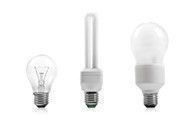 (MCT)—Buying a light bulb used to be easy. And it used to be something you did several times a year.
(MCT)—Buying a light bulb used to be easy. And it used to be something you did several times a year.
But now, “a lot of people are starting to look at light bulbs as an investment,” says Jaclyn Pardini, a spokeswoman for Lowe’s Home Improvement stores.
The incandescent bulbs in wide use ever since Thomas Edison received a patent for his version in 1880 are being phased out. A federal law passed in 2007 ends incandescent manufacturing and importing in the U.S. by the end of 2014, though stores will be allowed to keep them on shelves until they’re sold out.
In their place are more energy-efficient replacements that come in a dizzying array of hues and shapes.
But you’ll want to choose carefully. Those CFLs might be with you for the next nine years or so. And if you spring for an LED bulb, you’re really in it for the long haul.
“From the time a child enters kindergarten to the time that they graduate from college, that bulb will still work,” says Pardini of LEDs.
So as those last incandescents flicker out in your lamps and light fixtures, how do you decide what will replace them? Read on:
Incandescent
Cost: (one bulb): Less than $1; (to run for one year): $7.32
Life: 1,000 hours
Pros: It’s the warm, soft light you grew up with.
Cons: A hot-blooded energy hog. Federal law is phasing them out after 2014.
Halogen
Cost (one bulb): $2-$3; (to run for one year): $5.18
Life: 1,000-3,000 hours
Pros: The closest still-legal thing to the soft glow of an incandescent light. They’re now “the designer’s choice in bulbs,” says Lowe’s spokeswoman Jaclyn Pardini.
Cons: You’re not gaining much in life span or efficiency over incandescents.
CFL (compact fluorescent lamp)
Cost (one bulb): $1-$2.50; (one year): $1.57
Life: 10,000 hours
Pros: Here’s where energy efficiency really steps up. CFLs use 2/3 less energy than incandescents.
Cons: Early CFLs got a bad rap for being slow to warm up and casting harsh light. But they’ve improved a lot. Still, you reduce the life span a bit if you turn the light on and off a lot (less than 15 minutes of on time). Using CFLs in an enclosed fixture can also reduce their life span, but some newer models have overcome this.
Check the packaging for the bulb you’re considering.
Disposal can be a hassle. Each CFL contains a small amount of mercury, so you need to recycle old bulbs. Several retailers offer this service, and many municipalities allow drop-off at their household hazardous waste facilities. (Check search.earth911.com for listings.)
LED (light-emitting diode)
Cost (see note) (one bulb): $10-$30; (one year): $1.50
Life: 20,000-50,000 hours
Pros: Extremely long life. Cutting-edge technology.
Cons: Much higher upfront cost than other bulb types. But, Jaclyn Pardini says, “the potential return in energy savings and your time in changing out light bulbs is far greater over time. So it’s more of a longer-term investment.” Like CFLs, some LED bulbs can deteriorate in the heat of an enclosed fixture, so consult the packaging.
(Note: Cost figures are averages and based on 60W-equivalent single bulbs. Annual cost and life span based on three hours of use daily.)
©2013 The News & Observer (Raleigh, N.C.)
Distributed by MCT Information Services



